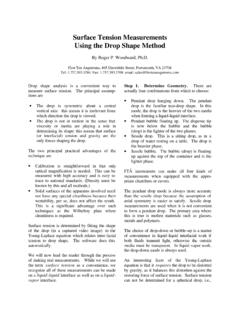Transcription of VISCOSITY MEASUREMENTS OF VARIOUS …
1 VISCOSITY MEASUREMENTS OF VARIOUS POLYMER/SOLVENT SOLUTIONS AND THEIR RELATION WITH ADIMENSIONAL NUMBERS INVOLVED IN THE ANTISOLVENT SAS TECHNIQUES Arlette Vega-Gonz lez*1, Pascale Subra-Paternault 1 Francesco Nudda1,2, Bruno Marongiu 21 Laboratoire d Ing nierie des Mat riaux et des Hautes Pressions, , Institut Galil e, Universit Paris 13, 99 Avenue Jean Baptiste Cl ment, 93430 Villetaneuse, France 2 Dipartimento di Scienze Chimiche, Universit di Cagliari, Cittadella Universitaria di Monserratto, 09042 Cagliari, Italy fax : 33 1 49 40 34 14 Carbon dioxide has been used as an antisolvent for the production of polymeric particles.
2 However, development of experimental conditions to control particle size and morphology of this kind of products is lacking. To help understanding the influence of spraying conditions on particle formation, kinematic VISCOSITY of liquid solutions of two polymers were measured. VISCOSITY MEASUREMENTS were carried out at different temperatures (25 C , 30 C and 35 C). The polymers studied were L-PLA and DL- PLGA. For L-PLA, solutions were prepared in pure dichloromethane since this solvent is largely used in spraying processes. In case of DL-PLGA, the polymer was dissolved in three different solvents, ethyl acetate, acetone and dichloromethane.
3 The VISCOSITY data were further used to compare the effect of polymer, organic solvent and solution concentration on particle morphology, through calculations of the dimensionless numbers of Reynolds and Weber. INTRODUCTION Polymer microparticles and fibres are of interest as potential drug delivery systems and biodegradable filler material. Different organic and inorganic materials have been processed employing the supercritical fluids as solvents or antisolvents. Materials having different morphologies - particles, fibres, films - have been obtained with different techniques.
4 When compressed gases are used as antisolvents, and a dissolved solute is sprayed into a compressed gas, the process is known as supercritical antisolvent process (SAS). This process generally uses CO2as the antisolvent, and the operating pressure and temperature are usually selected so the solvent and the antisolvent are completely miscible. Few studies concerning the mechanisms controlling polymer particle morphology when using supercritical fluids as antisolvents have been published. The first parametric studies were carried out by Dixon et al.[1] and Randolph et al.
5 [2], and they indicate that a transition from microparticles to microfibres occurs with an increase in solution VISCOSITY , or atomization time, for a given solution velocity, pressure and temperature. This dependence on VISCOSITY results from the transition to nondilute polymeric solutions, where the polymer has a large effect on the fluids properties, such as surface tension and non-Newtonian behavior, as the solvent concentration decreases [3]. The critical concentration causing this transition will vary with the polymer [4]. More recently, Lengsfeld et al.[3] studied the mechanisms governing particle morphology in polymers and found that presumably, microparticle formation results from gas phase nucleation and growth within the expanding plume, rather than nucleation within discrete liquid droplets.
6 Lately , P rez de Diego et al.[5] provided experimental evidence for the hypothesis that when processing polymer solutions there are two different mechanisms of droplet formation governing the final size of the precipitated particles: hydraulic atomization and liquid-liquid phase split. They demonstrate that when working at conditions below the mixture critical pressure (MCP) it was possible to produce polymer particles. At conditions where the two fluids are completely miscible, smaller particles and microfibers were obtained. In this work, VISCOSITY MEASUREMENTS of two different polymers, poly lactic acid and poly-lactide co-glycolide were carried out in order to compare the possible influence of different parameters such as polymer type or concentration, on the atomization process, and thus on particle morphology.
7 Calculations of the dimensionless numbers of Reynolds and Weber have been used in order to compare the different experimental conditions. I- MATERIALS AND METHODS Materials L-Poly(lactic acid) (L-PLA, MW : 100 000) was obtained from Galastic Laboratories, Belgium. Poly(DL-lactide-co-glycolide) (PLGA, 50:50, inherent VISCOSITY ) was obtained from Aldrich, France. Methylene chloride (DCM, Chromanorm grade), acetone (ACE, Normapur grade) and ethyl acetate (ETHY, Chromanorm grade) were obtained from Prolabo (France) and used without additional purification. CO2(99%, industrial grade) was purchased from Air Liquide (France).
8 Methods VISCOSITY measurementsViscosity MEASUREMENTS were carried out using a Ubbelohde-type capillary viscometer, they were performed at 25, 30 and 35 C. All the polymer solutions were used immediately after preparation. The viscometer was immersed in a constant temperature bath that was controlled to within C, the efflux times were reproducible to %, and the flow times were measured with an accuracy of s. For the molecular weight investigated, shear effects were assumed to be negligible. The concentration dependence of the VISCOSITY of polymer solutions was followed by the well-known Huggins equation [6] : [][]ckcHsp2/ +=(1) where sp is the specific VISCOSITY , c is the solution concentration,[] is the intrinsic VISCOSITY and Hkis a constant.
9 The instrinsic viscosities - which reflect the capability of a polymer in solution to enhance the VISCOSITY of the solution - were obtained from plots of the csp/ ratio against the polymer concentration, with subsequent extrapolation to infinite dilution. Precipitation experimentsThe apparatus used for the experiments was operated in a semi-continuous mode. The description of the experimental set-up can be found elsewhere [7]. II- RESULTS AND DISCUSSION VISCOSITY MEASUREMENTS The VISCOSITY MEASUREMENTS carried out allowed to represent plots of the csp/ ratio against the polymer concentration. This plots (which are not presented here) show that a linear relationship exists.
10 Then, from equation (1) it is possible to calculate the VISCOSITY parameters of the different systems. Theses parameters are presented in Table 1. In this table, C* corresponds to the overlap concentration, at which polymer coils begin to overlap each other (separating semi-dilute and dilute regimes in polymer solutions). C* can be approached from the reciprocal of the intrinsic VISCOSITY ([] /1*=C) [8]. The constant kHis a measure of the solvent quality. When the polymer is in a good solvent, its value is near 1/3, and it can increase up to 1 for solutions in poor solvents [9].







